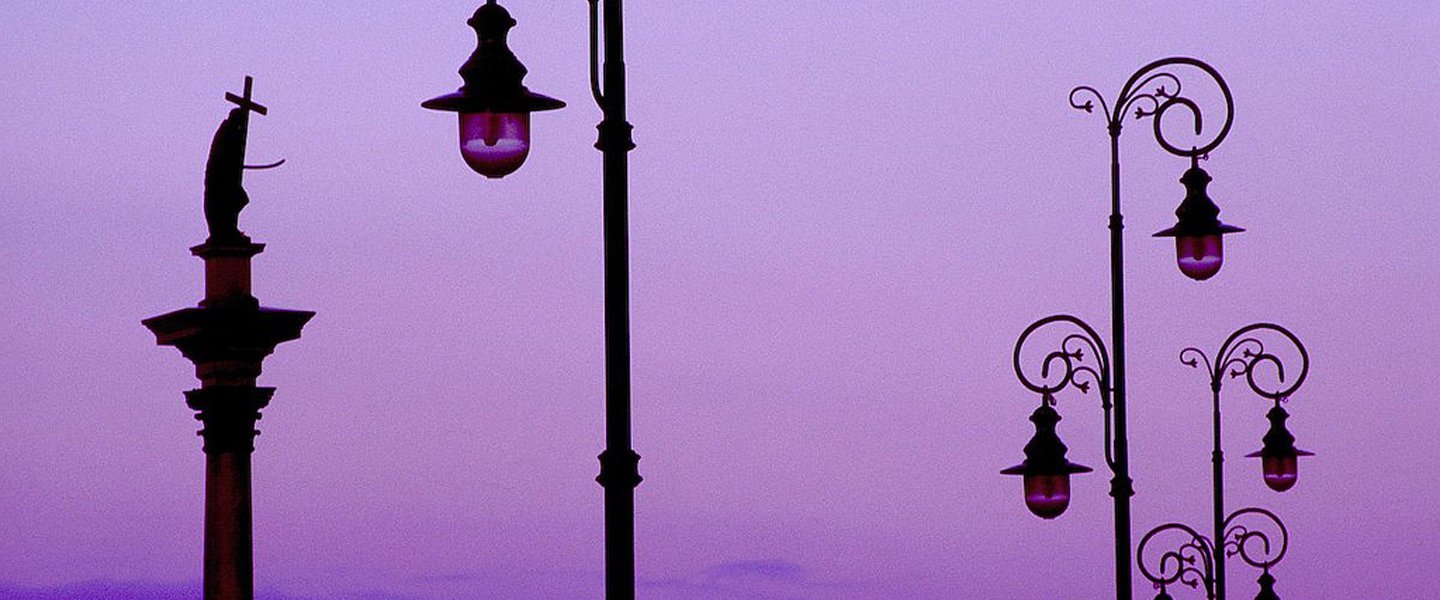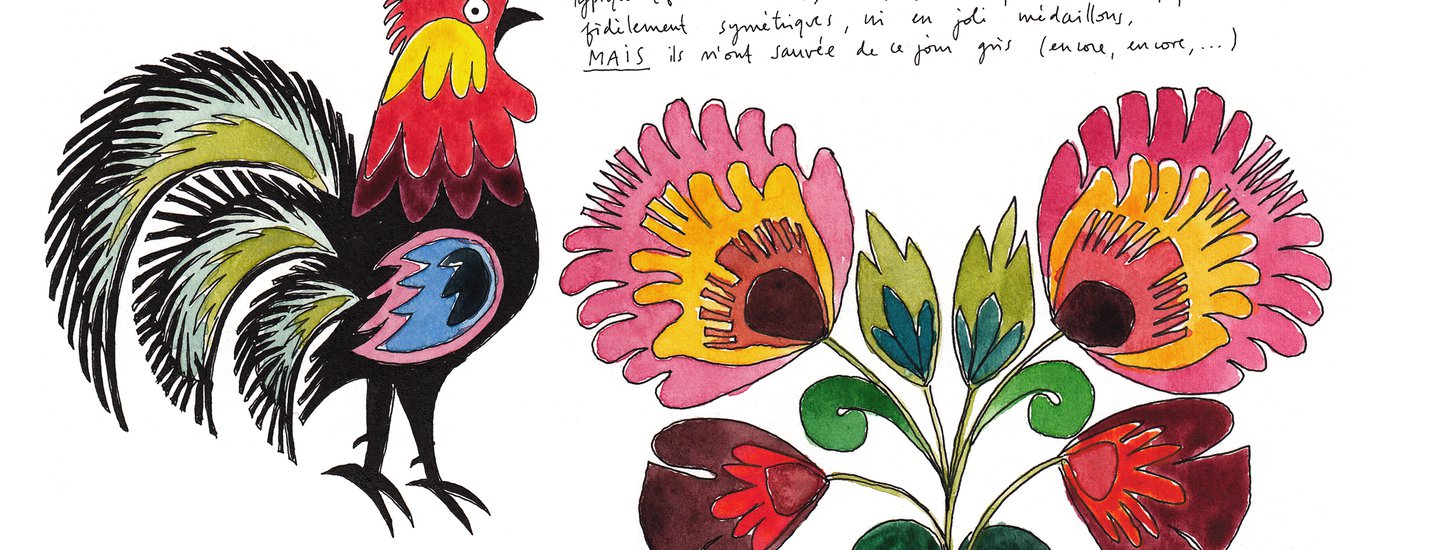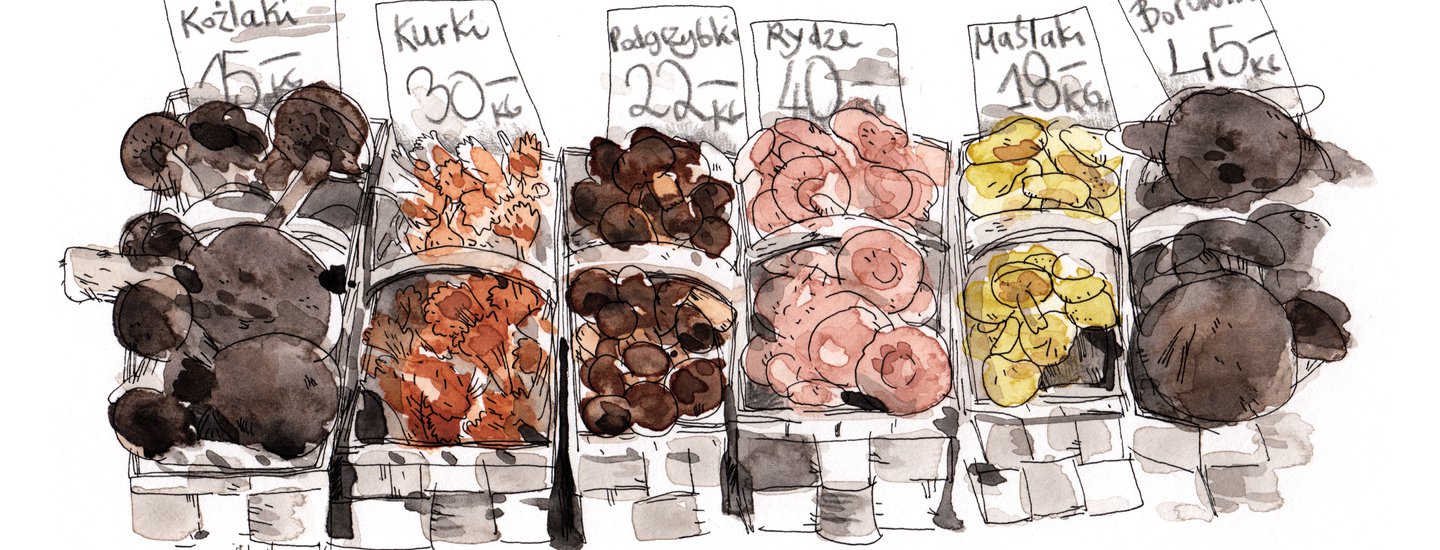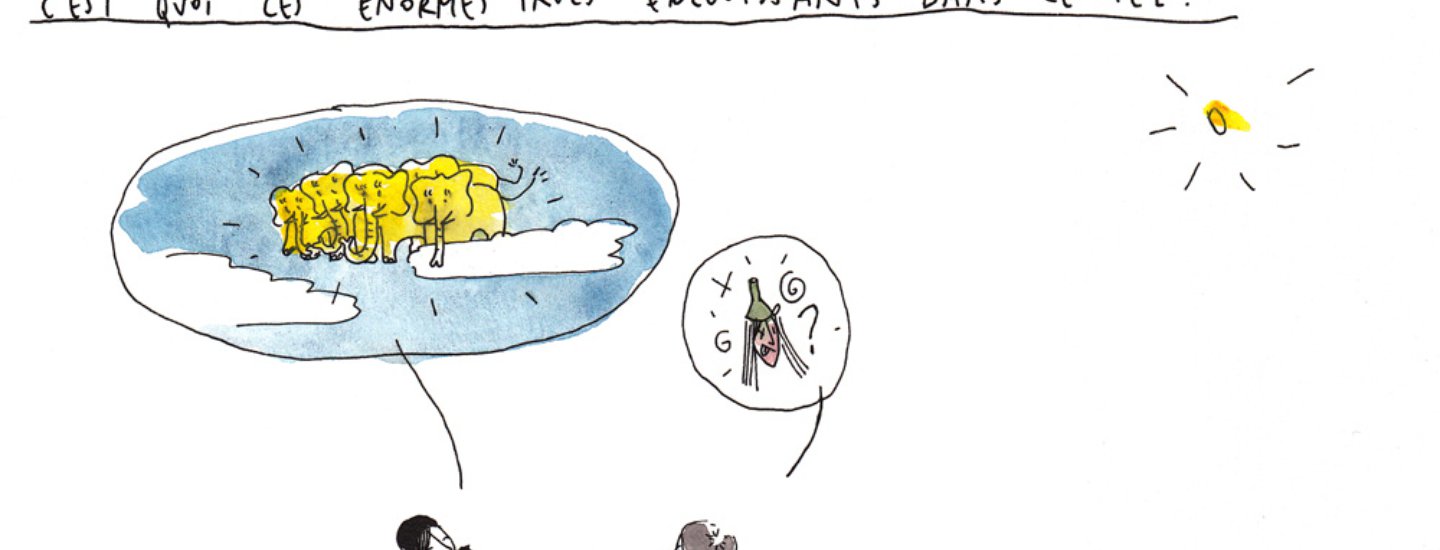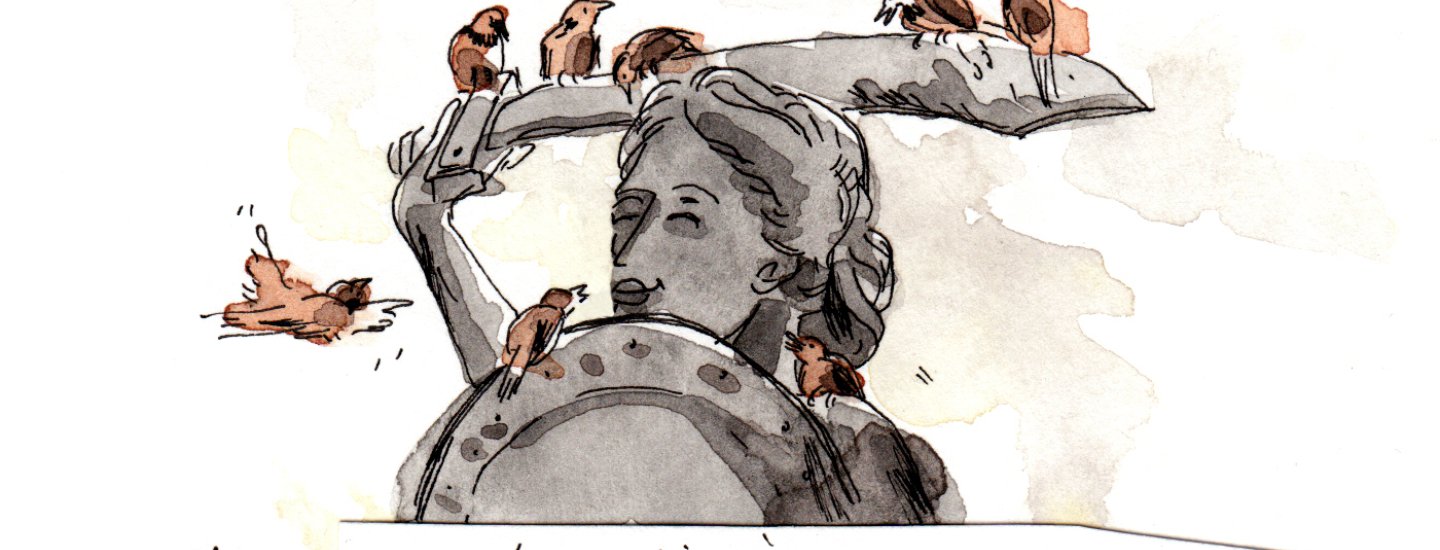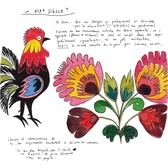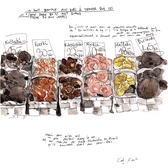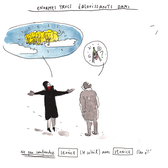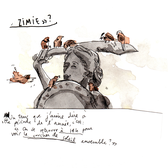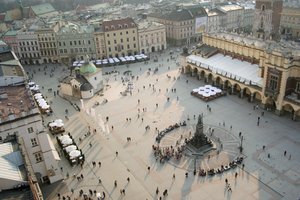Poland in the eyes of a Swiss graphic artist
Fanny Vaucher, a Swiss graphic artist living in Warsaw, author of a graphic blog “Pilules polonaise” (Polish pills), talked to Polska.pl website about pickled cucumbers and how to draw Poland in pills that would be understandable to foreigners.
Magdalena Majewska, Polska pl: What are "Polish pills"?
Fanny Vaucher*: When I came to Poland, I had pills with me in the colours of the Polish flag, by accident. I then had that funny thought that these are the pills that will allow me to become Polish. And hence the name of my blog. People quickly gave another meaning to my pills – they believe that I draw small doses of Poland for foreigners who would like to see Poland through my eyes. It's true, Polish pills is a way to make Poland familiar, step by step. Pill by pill, I create my bond with this community and this culture.
What surprised you in Poland?
In the beginning, I was surprised by the very looks of Poland from the train window – endless flat villages, extensive forests, and then inconsistent Warsaw's architecture, where state-of-the-art skyscrapers are located just next to abandoned places. And the sizes: wide alleys, long post-war buildings, it was all new and fascinating for me. I was also surprised by the fact that Poland is a very Catholic country. I come from a protestant region, where religion is not particularly visible in public. For example, I know a lot of young people that are already married, or divorced, and it's very rare among my friends in Switzerland. As regards the mundane stuff, I was surprised – and the people that came to visit me were surprised, too – that people in Warsaw dress very elegantly. It seems to me that the local customs say that you should look good when you leave the house, much better than in Switzerland or in Germany.

One of the Fanny's "Polish pills": Why "milk bars" are called milk bars?
Milk bars are typically Polish places. At the moment, dishes containing meat dominate the menus, but in the beginning (the first milk bar was opened in Warsaw in 1896) only milk dishes were served, without any meat.
My most frequent order at milk bars is:
potato pancakes sprinkled with sugar, potato purée with mushroom sauce, and pickled cucumbers (cut into quarters).
It all costs around PLN 10 (3 francs).
Milk bars became popular in the inter war period. They receive subsidies from the state, so that the poor can eat there at very convenient prices. A lot of students and elderly people frequent milk bars.
We often hear that Polish is difficult foreigners. Did you have any problems with it?
Polish is not an easy language, but it can be learned – I meet many immigrants that managed to do so. I'm a victim of disorganisation. I haven't managed to sign up for a course since my arrival and I keep putting it off, despite my curiosity and interest in your language, which I believe is beautiful. I understand a little, but I don't speak Polish. It creates a distance between me and my environment, but it also stimulates my creativity – drawing and writing are my attempt to make that distance smaller.
Is Polish cuisine as good as the Polish people believe?
This is certainly a type of cuisine I wasn't accustomed to! I was raised in the Mediterranean cuisine traditions, so the traditional Polish dishes in breadcrumbs, cooked, fried, made of flour (dumplings and croquettes), and most of all – marinated and pickled products, like my favourite pickled cucumbers, were new to me. I cook a lot and I quickly included my favourite Polish dishes in my daily menu – I'm a vegetarian. You can see it in my drawings, I present what I love the most in Polish cuisine: dumplings, borscht, mushrooms, cucumbers in all flavours, and so on. They are not only tasty, they look great and they are art elements in my everyday live.
And what is it that you don't like about Polish cuisine?
I think that it's traditional version lacks fresh fruit and vegetables. And there's too much meat in it, but this applies to the majority of European cuisines, and I think it started to change.
Which blog post was the most popular?
I noticed that the popularity of my blog posts does not depend on their visual quality, but on the topic. I'm much more critical about my drawings than my readers. For examples, the entries "Why so many people have the same names" or "Why do films have voice-over commentary instead of being dubbed" had many comments, even though they didn't have many graphics, and the drawings about films were only average. One of the most popular posts is entitled "Why cash desk clerks never have change!" It's not a serious topic, but it was fun for me and it turned out that everyone experienced that. From the recent posts, the one that criticises the ubiquity of Facebook in Warsaw's life is a popular one.
Which drawing is your favourite? Was there a drawing that irritated Polish people?
I like to go back to drawings that I like from the graphics perspective, like the post about the Polish romanticism, with pine and birch forests. As regards content, I prefer political ones, e.g. about the increasing nationalistic moods. To my surprise, there were no negative comments. Only the post about shale gas extraction in Poland had some heated debate in the comments, but it's normal, as it's a generally controversial topic and it's good that people talk about it.
What are Polish people like? How do we differ from Swiss people?
Far be it from me to generalize, but it seems to me that Polish people are very emotional. Maybe it's the legacy of romanticism? The atmosphere here is completely different than in Switzerland. Also, I was surprised to see how much history is important for the identity of Polish people. You don't see it in Switzerland, which did not experience major tragedies and where people base their identity in a calmer, more stable and comfortable manner. Here, history is everywhere, in every building, in every family. It is present everywhere – and it's alive. These are all dramatic experiences, fights, victories, which must give people the sense of who they are and where they come from. I haven't grasped it yet.
I draw small doses of Poland for foreigners who would like to see Poland through my eyes. It's true, Polish pills is a way to make Poland familiar, step by step. Pill by pill, I create my bond with this community and this culture – Fanny Vaucher
History influences the approach of Polish people to Warsaw. Hardly anyone likes it and people believe it is ugly. I love this city, because my family has been living here for generations, my grandmother fought in the Warsaw Rising in 1944. The history of rebirth of this city makes it unique. Why do you like Warsaw? What makes it different from Swiss cities?
I think that what you've just said reflects the feelings of many people about Warsaw. It's not about how the city looks, it's about its history and atmosphere, right? This is why I like Warsaw, for its intensity and for all its stories it has to tell. I like its chaotic looks, the looks of a city still under construction, full of contradictions, imperfect. There is an energy here that enlivens the public space. You can say that people want to have an impact on how their environment changes, they are full of ideas, they are brave and determined to create a city they will be comfortable in. It is a very inspiring place where I can feel free and find myself.
What is your favourite place in Warsaw?
I could talk about picturesque or historic places, but truth be told, my favourite place is Inside Bar, a small students' bar, not a fashionable one, in a dark alley off Nowy Świat. There is that dark, weird climate of the end of the world that I simply love. I went once for a trip around the city with a guide, and when we stopped there, the guide said that this bar proves that Warsaw still has ugly places! At least when I go for a beer with my friends there, I can be sure that it won't be crowded with tourists!
Do you like modern Polish culture? Do you have a favourite painter, graphic artist or composer?
It's a bit embarrassing, but I still don't know modern culture too well. Ever since my first visit here I was fascinated with Polish poster art, I appreciate such artists as Ryszard Kaja or Ryszard Kajzer in particular. As regards painting, I was happy to see the works of Rafał Bujnowski. But you have to ask me again, when I've had the change to spend more time on it... at least that's the plan!
Can you earn your living in Poland from drawing?
No, unfortunately. I had hoped so when I came here, but I have the impression that the illustration market here is very difficult, you have to work a lot and be very patient to find your place in it. There are a lot of great artists and few clients or institutions that offer fair money. As far as I know, a lot of young people do illustrations - and other stuff as well – practically for free. I don't understand it why artistic work is not appreciated, you don't ask your mechanic for free tyres. In Poland, I earn my living only thanks to the commissions from Switzerland. I don't know if publishing a book will change anything.
How did "Polish pills" come to life as a book?
As I'm very critical to my work, I couldn't even imagine that anyone could be interested in it. It was my friends who almost forced me to contact publishers and Pro Helvetia foundation (a Swiss Foundation for Culture) in order to get funding to publish the book. Bęc Zmiana Foundation, whose projects I liked a lot, got interested straight away. We still didn't have enough funds, so I contacted Vera Michalska with Noir sur Blanc publishing house, who suggested that they will be co-publishers, which will also make it possible to publish the book in France and Switzerland. It is fantastic that my first book was published by such high-class publishing houses, and I'm so happy that it is also available abroad!
Why did you came to Warsaw – for work or for love?
Love, of course. It was one of these rare moments in life when you can just drop it all and go to a new place. Poland was an obvious choice, because I knew hardly anything about it, I didn't have any associations with it, as with Paris or Berlin, and also because I wanted to be close to people I love. In Switzerland, I had a lot of Polish friends who told me about their childhood and brought me marinated mushrooms or Polish alcoholic beverages from Poland. I didn't have any ideas, I never thought about what Poland looks like, I haven't looked at photos. And that lack of any idea made me crave coming to your country. Today I feel like a part of that mixture of images, places, items, people and events. I think that my drawings reflect what I see quite well. There are still things that surprise me, I have still a lot of questions, just as in the beginning.
Such as?
Why residents of Kraków spend so much time in cafés? How many wild European bisons live in the East of Poland? Where does the name Warsaw come from? And many others, but you have to be patient. You will find answers on my blog soon!
Interviewed by MAGDALENA MAJEWSKA
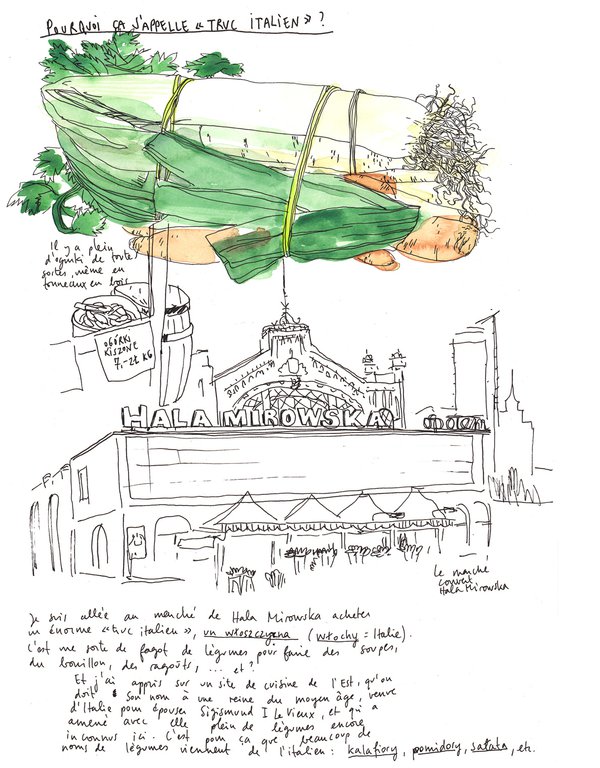
Where does the name "włoszczyzna" (literally: Italian vegetables) come from?
Hala Mirowska, market under a roof.
There are many types of cucumbers in wooden barrels.
I went to Hala Mirowska to buy włoszczyzna. It is a set of vegetables for making a soup, a bouillon, or stew, etc. While reading an oriental cuisine website I learned that włoszczyzna takes its name from an medieval queen from Italy that married the Sigismund I the Old, a Polish king, and brought different vegetables with her that were not known in Poland at that time. This is why many Polish names for vegetables come from Italian, e.g. cauliflower, tomato, lettuce, and so on.

* Fanny Vaucher – graduate of literature at the Lausanne University and of illustration and comics at l'Ecole des Arts Appliques in Geneva. She is a proofreader and independent illustrator, she creates fanzines. Since October 2012 she runs a blog called Pilules polonaises, which was published as a book in December 2013.
01.12.2014
